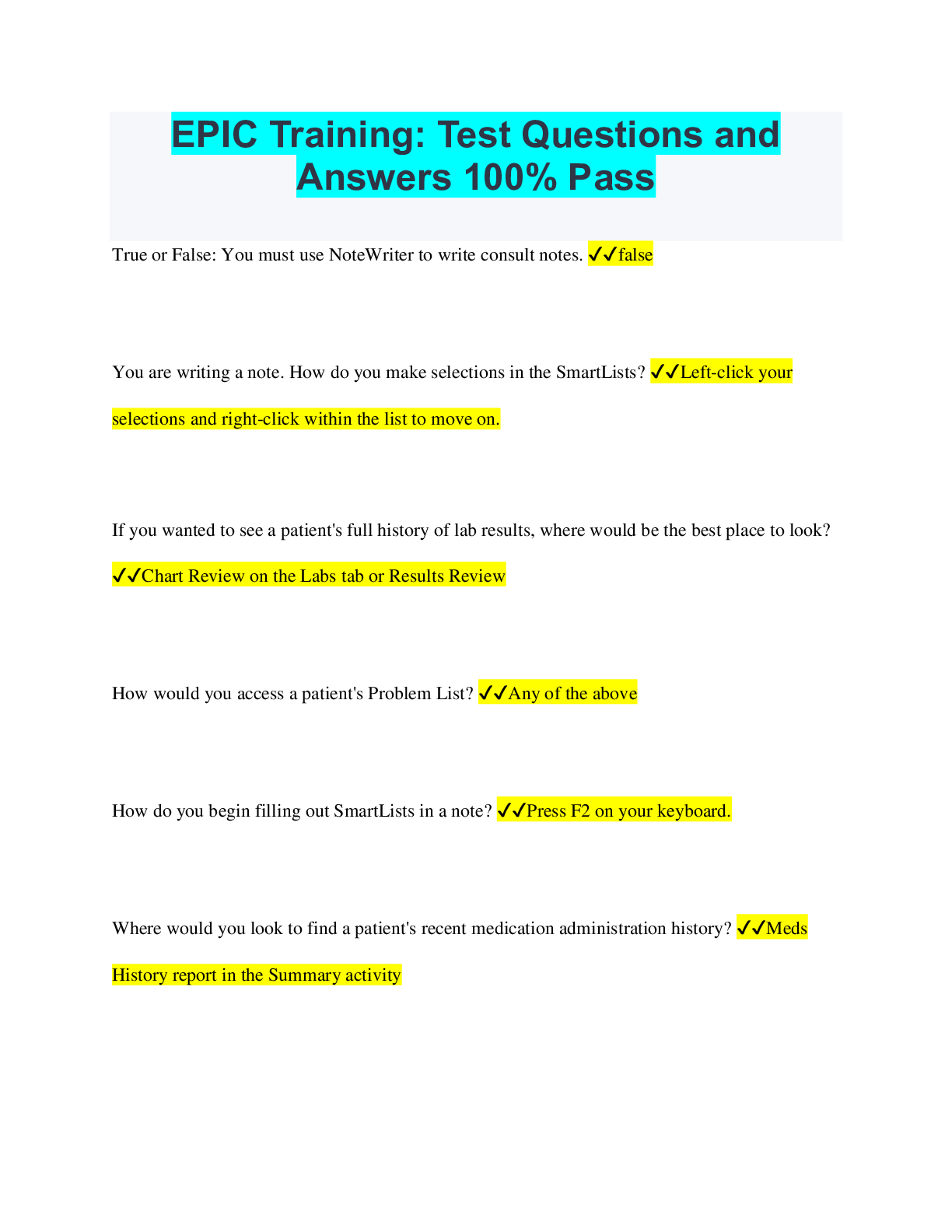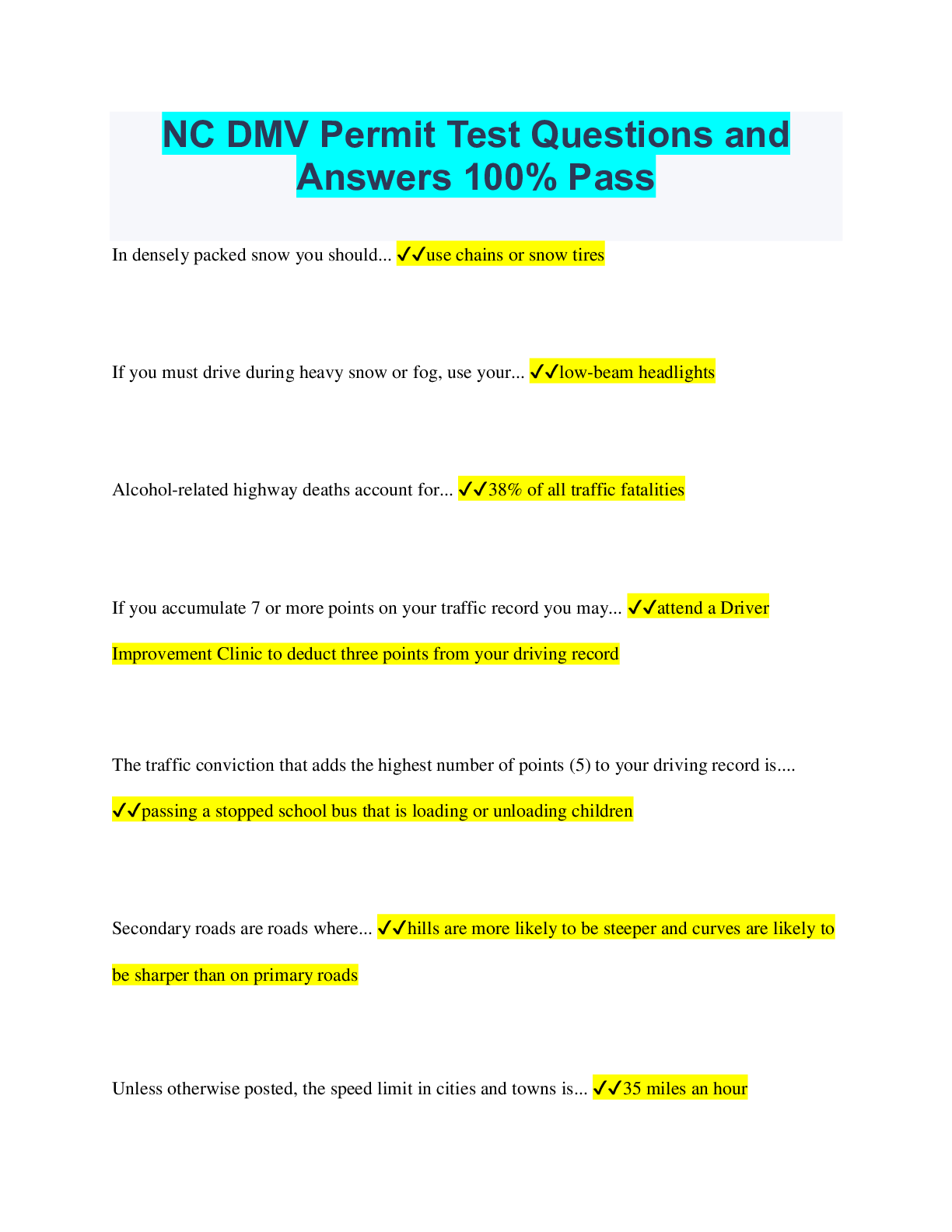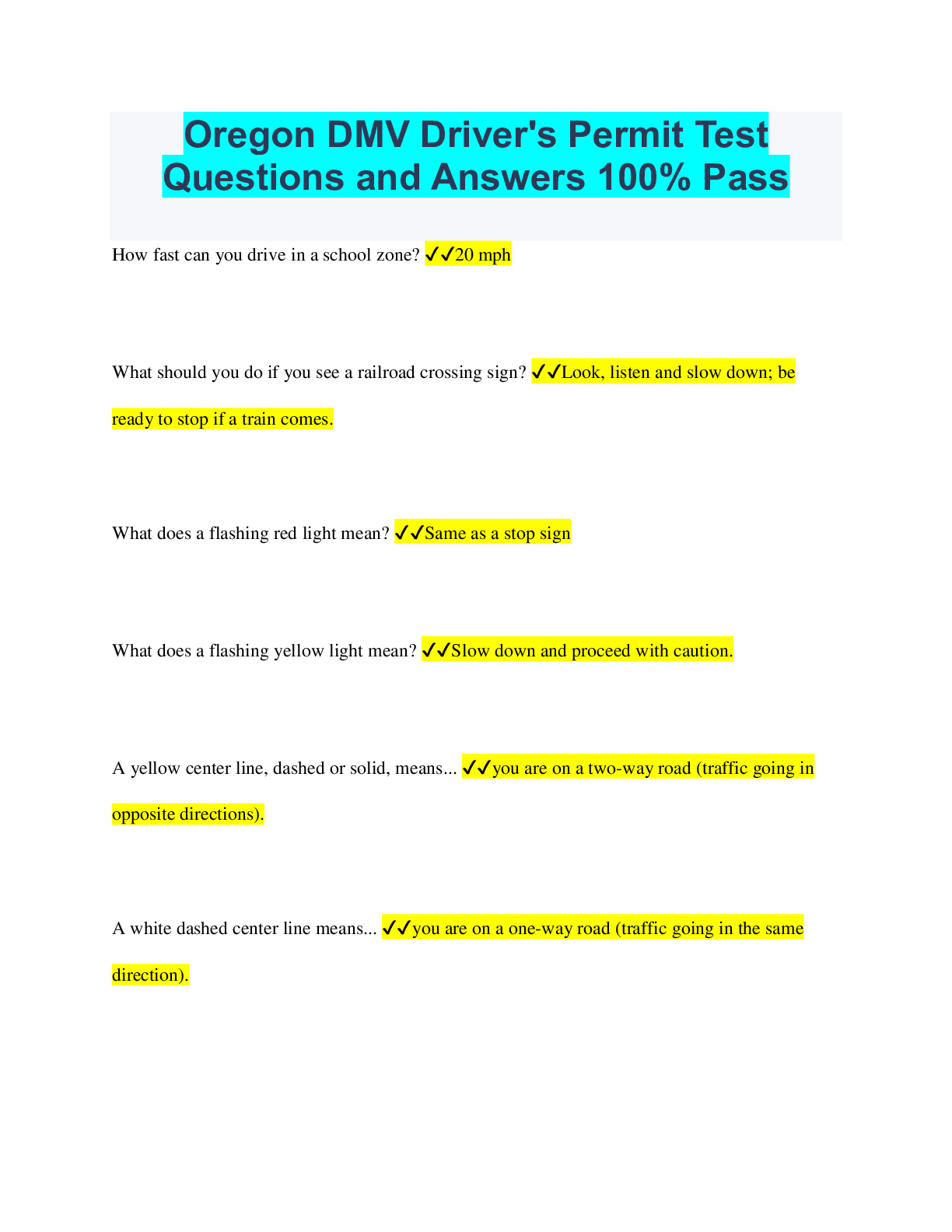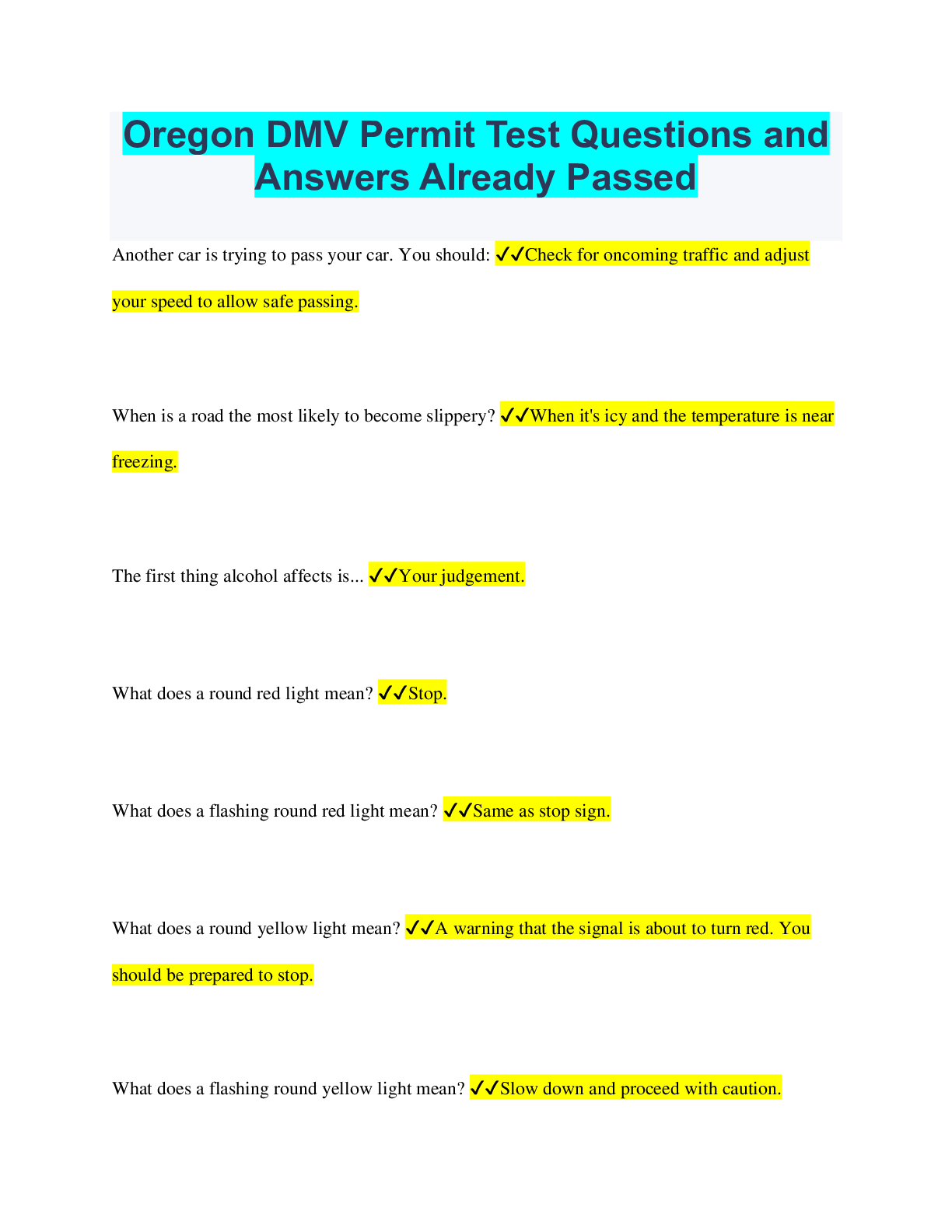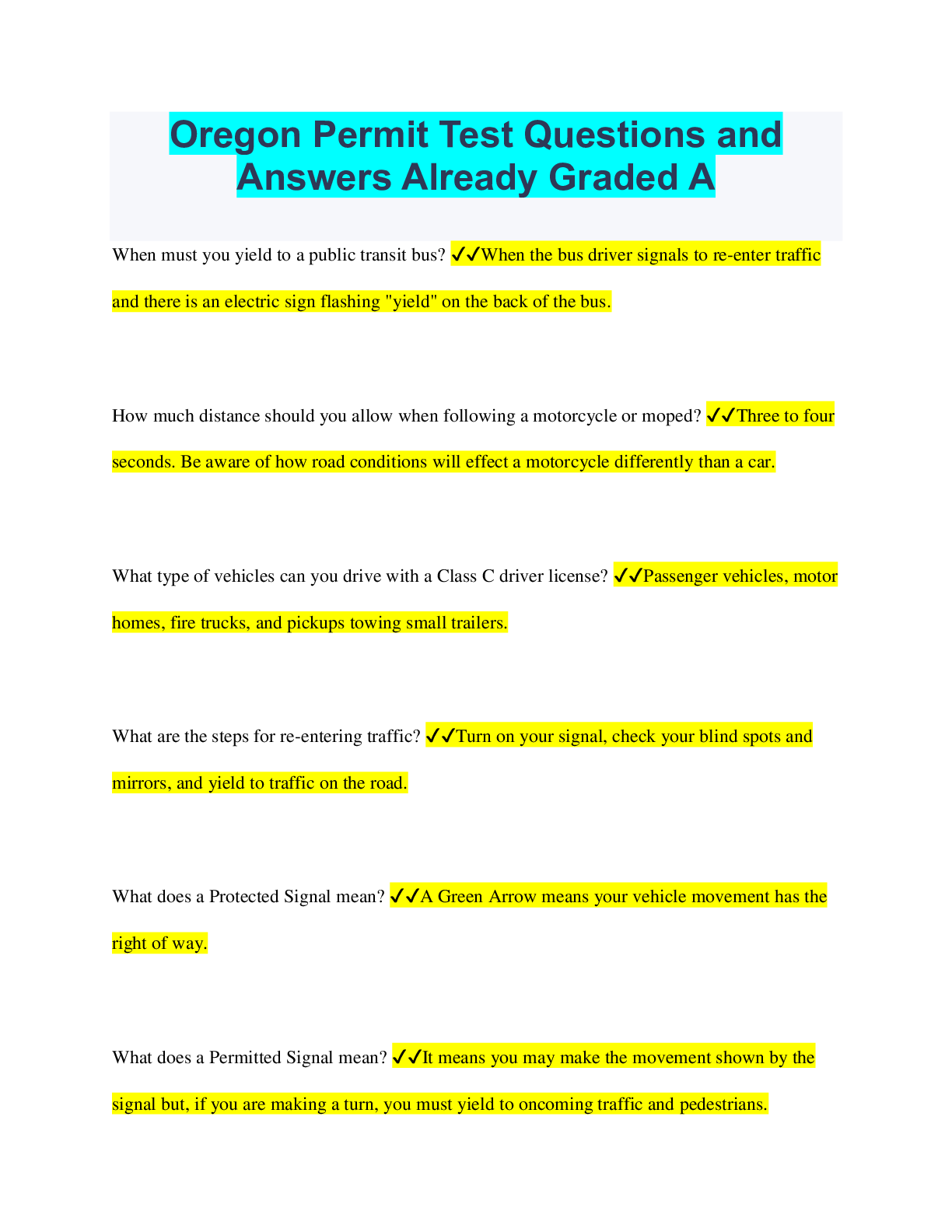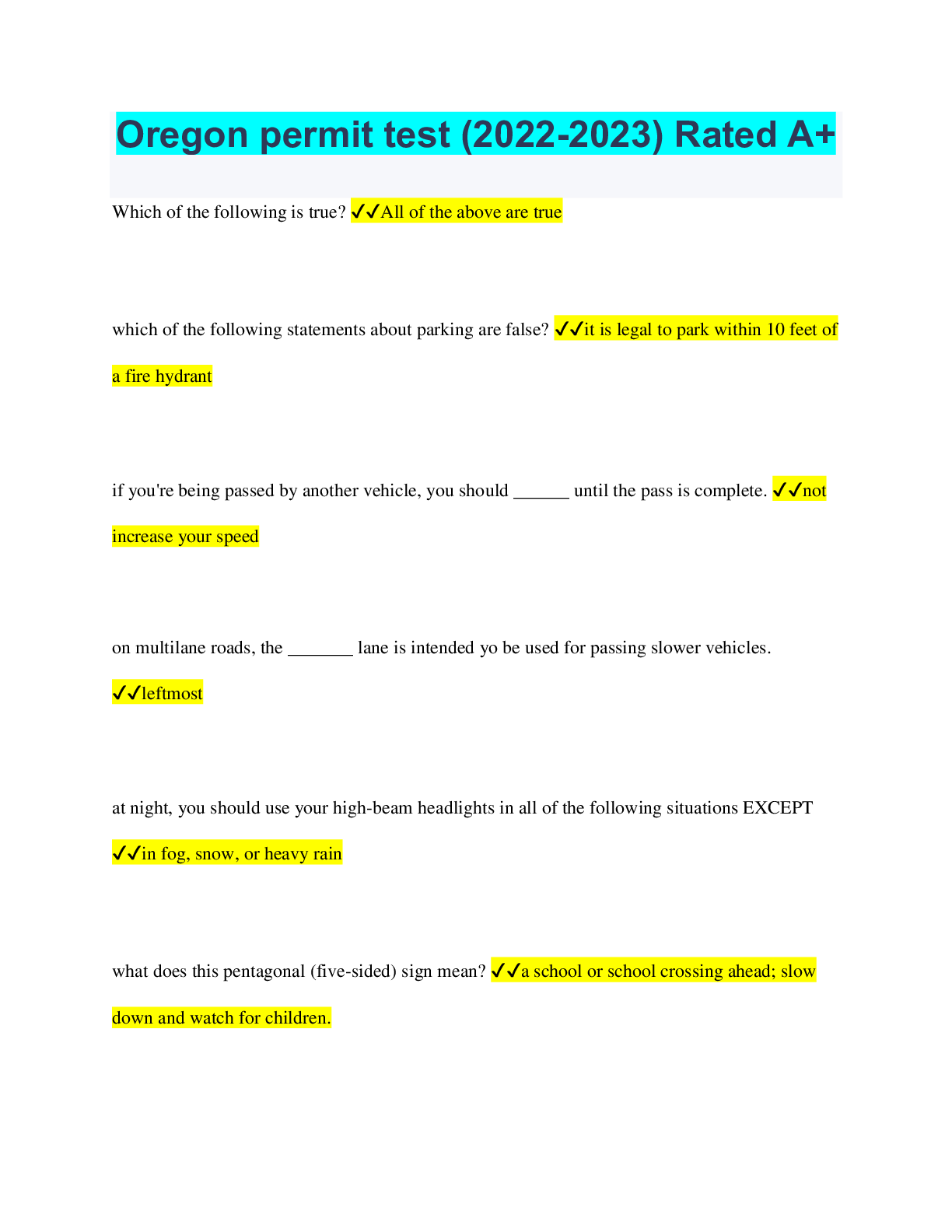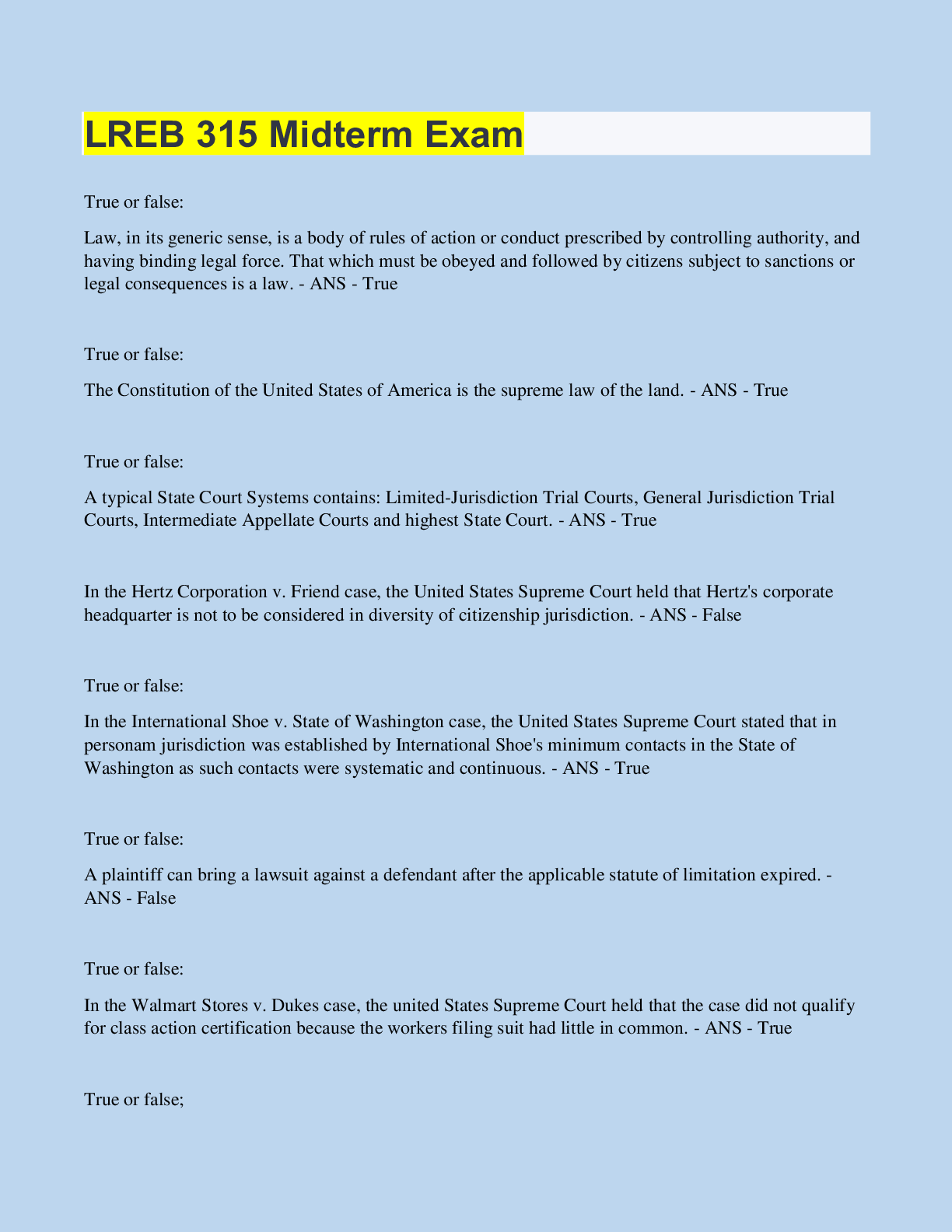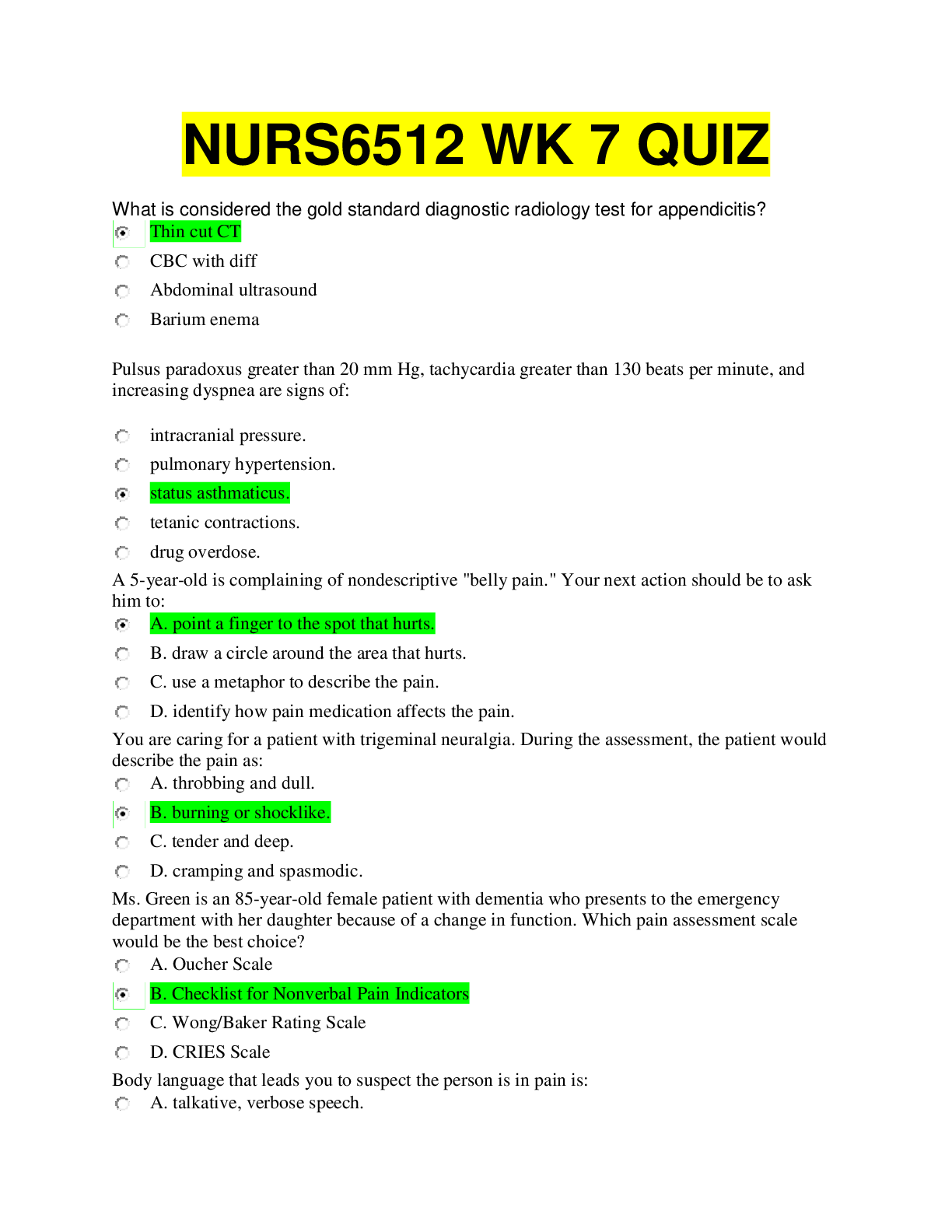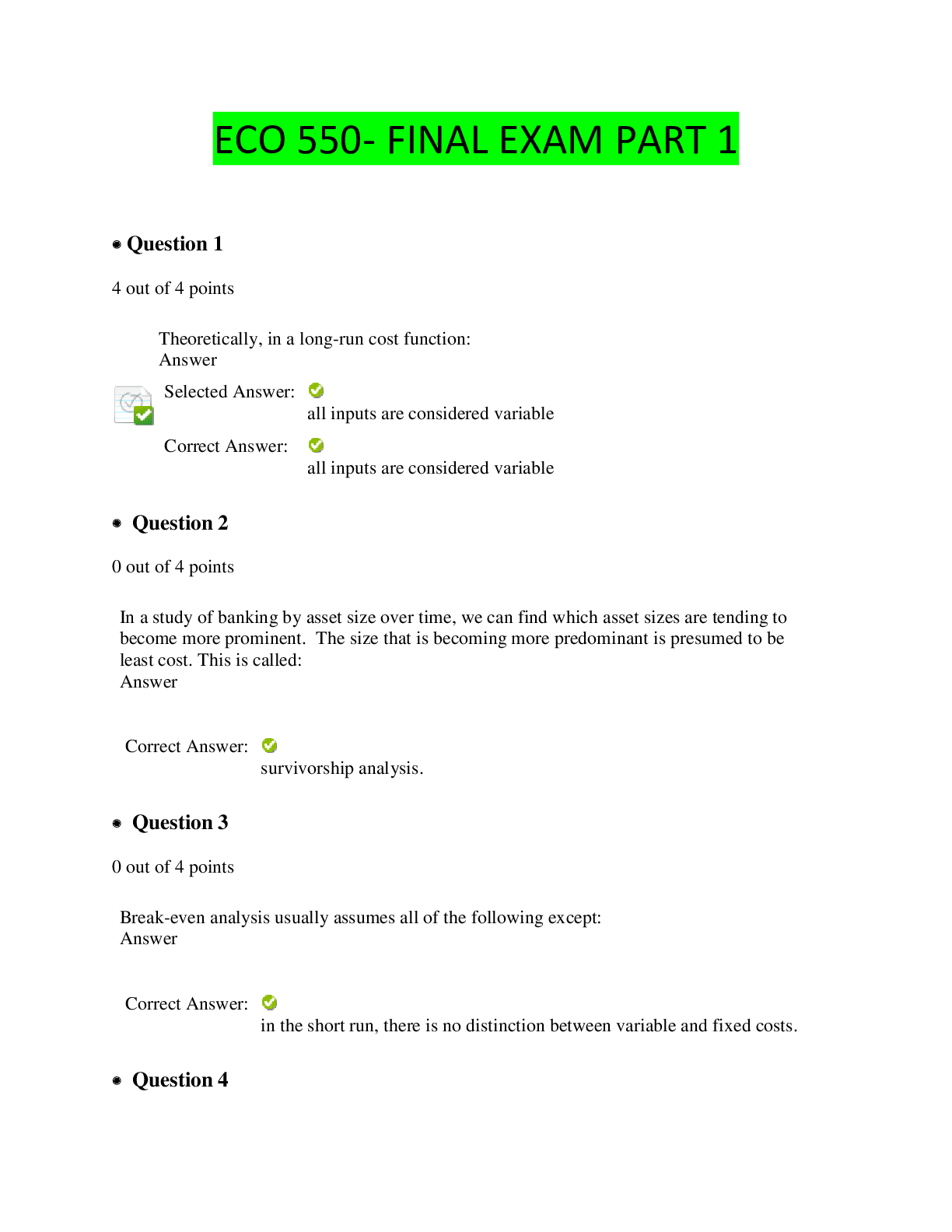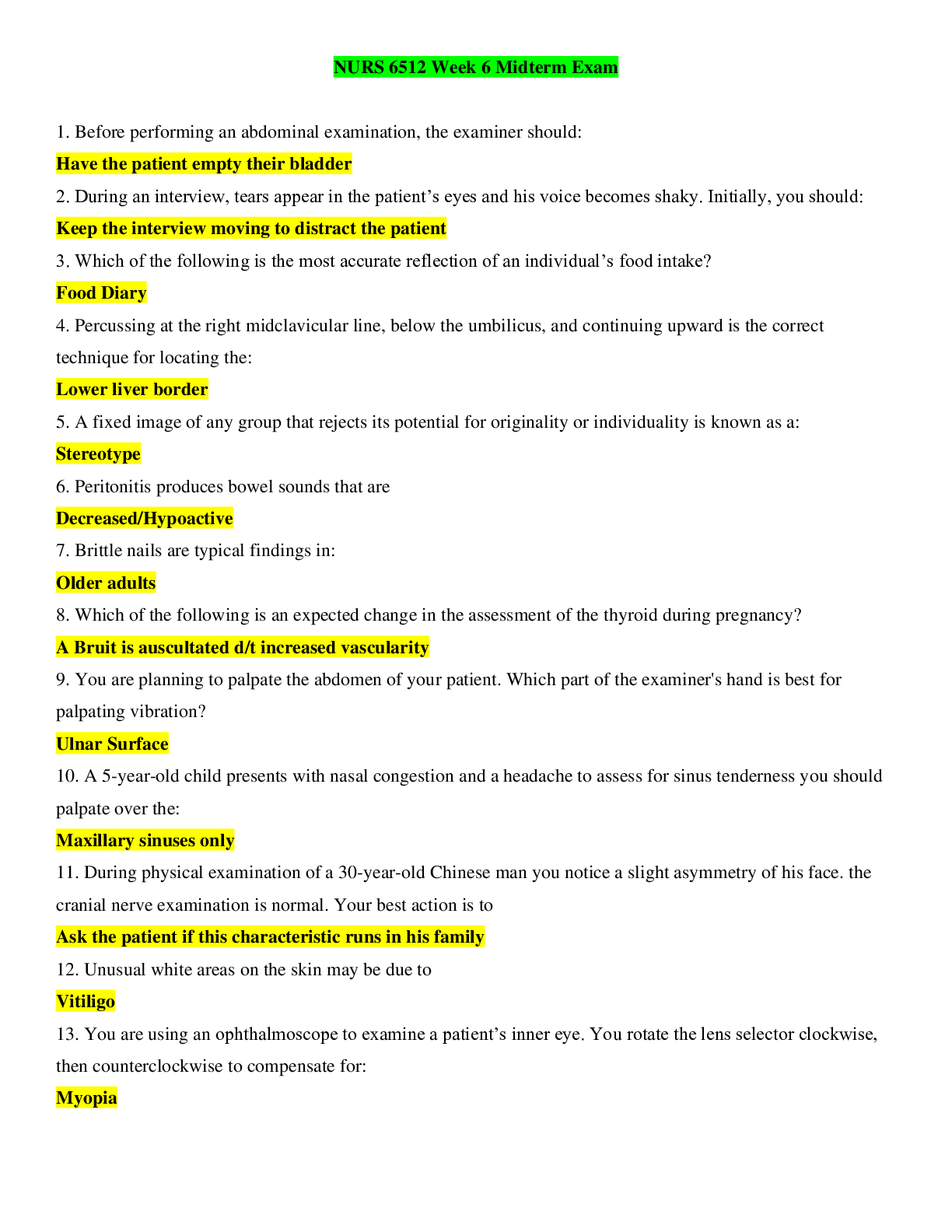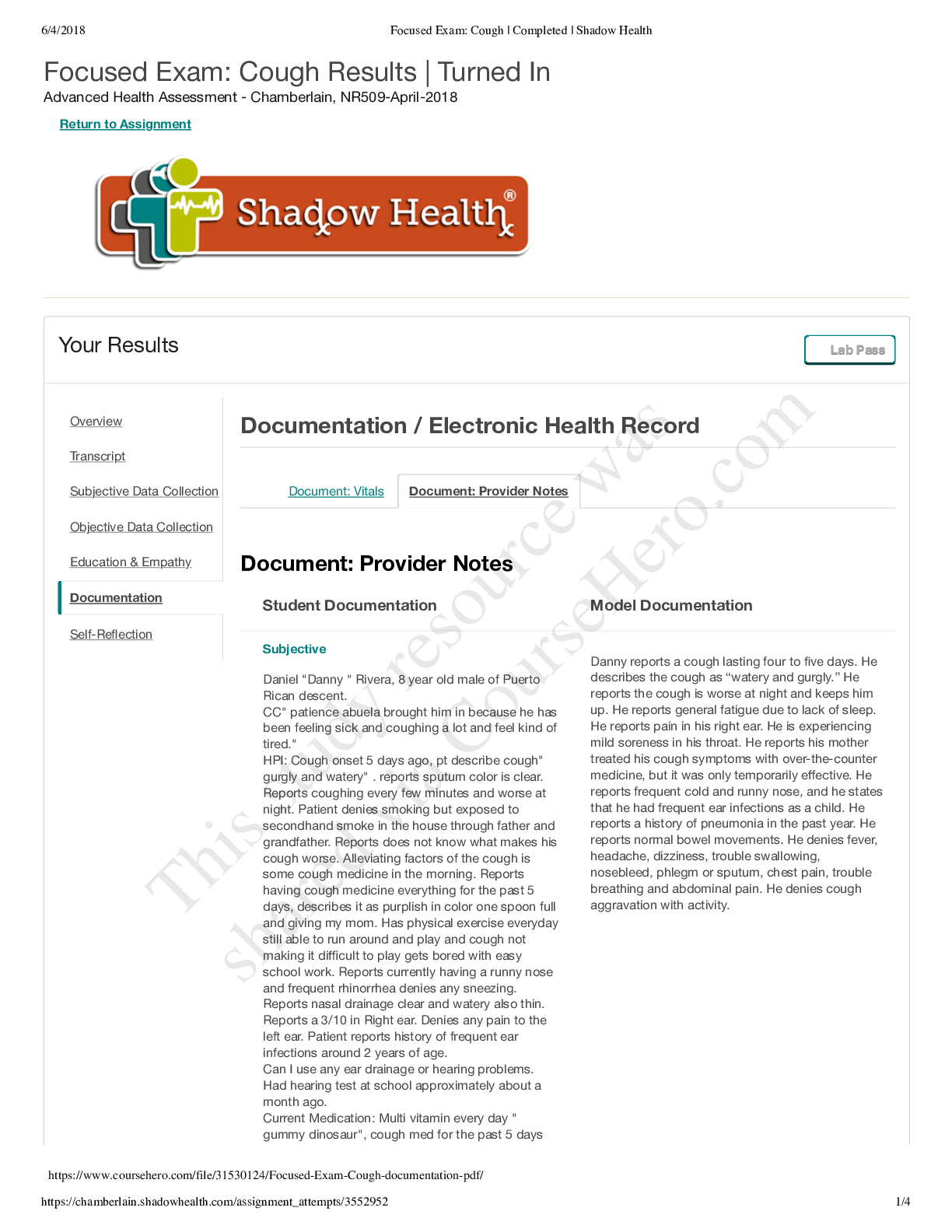*NURSING > QUESTIONS & ANSWERS > NUR 634 Advanced Health Assessment and Diagnostic Reasoning With Skills Lab - Final Exam Test Prep L (All)
NUR 634 Advanced Health Assessment and Diagnostic Reasoning With Skills Lab - Final Exam Test Prep Latest 2019/2020, A Work
Document Content and Description Below
NUR-634 Final Exam Test Prep You are examining an elderly man and notice the following: Decreased vibration sense in the feet and ankles, diminished gag reflex, right patellar reflex less than ... the left, and diminished abdominal reflexes. Which of these is abnormal? Decreased vibration sense Diminished gag reflex Diminished right patellar reflex compared to the left Diminished abdominal reflexes Question Points: 1.0 / 1.0 A 68-year-old retired farmer presents to your office for evaluation of a skin lesion. On the right temporal area of the forehead, you see a flattened papule the same color as his skin, covered by a dry scale that is round and feels hard. He has several more of these scattered on the forehead, arms, and legs. Based on this description, what is your most likely diagnosis? Actinic keratosis Seborrheic keratosis Basal cell carcinoma Squamous cell carcinoma Question Points: 1.0 / 1.0 A 14-year-old junior high school student is brought in by his mother and father because he seems to be developing breasts. The mother is upset because she read on the Internet that smoking marijuana leads to breast enlargement in males. The young man adamantly denies using any tobacco, alcohol, or drugs. He has recently noticed changes in his penis, testicles, and pubic hair pattern. Otherwise, his past medical history is unremarkable. His parents are both in good health. He has two older brothers who never had this problem. On examination, you see a mildly overweight teenager with enlarged breast tissue that is slightly tender on both sides. Otherwise his examination is normal. He is agreeable to taking a drug test. What is the most likely cause of his gynecomastia? Breast cancer Imbalance of hormones of puberty Drug use Alcohol use Question Points: 1.0 / 1.0 A 17-year-old female presents to your office, complaining of a clear discharge from her right breast for 2 months. She states that she noticed it when she and her boyfriend were “messing around” and he squeezed her nipple. She continues to have this discharge anytime she squeezes that nipple. She denies any trauma to her breasts. Her past medical history is unremarkable. She denies any pregnancies. Both of her parents are healthy. She denies using tobacco or illegal drugs and drinks three to four beers a week. On examination, her breasts are symmetric with no skin changes. You are able to express clear discharge from her right nipple. You feel no discrete masses and her axillae are normal. The remainder of her heart, lung, abdominal, and pelvic examinations are unremarkable. A urine pregnancy test is negative. What cause of nipple discharge is the most likely in her circumstance? Benign breast abnormality Breast cancer Nonpuerperal galactorrhea Pagets disease Question Points: 1.0 / 1.0 A 26-year-old flight attendant presents in for a third trimester prenatal visit. She has had prenatal care since her sixth week of pregnancy. She has no complaints today and her prenatal course has been unremarkable. Today her blood pressure and weight gain are appropriate, and her urine is unremarkable. You have a first-year medical student shadowing you, so you ask the student to get Doptones and measure the patient's uterus in centimeters. The nurse practitioner student promptly reports fetal heart tones of 140, but he is having difficulty obtaining the correct measurement. He knows one end of the tape goes over the uterine fundus. From what inferior anatomic position should the tape be placed? Vagina Clitoris Pubic symphysis Umbilicus Question Points: 1.0 / 1.0 A 58-year-old gardener presents to your office for evaluation of a new lesion on her upper chest. The lesion appears to be “stuck on” and is oval, brown, and slightly elevated with a flat surface. It has a rough, wart like texture on palpation. Based on this description, what is your most likely diagnosis? Actinic keratosis Seborrheic keratosis Basal cell carcinoma Squamous cell carcinoma Question Points: 0.0 / 1.0 Which of the following represents age-related changes in the lungs? Decrease in chest wall compliance Speed of expiration increases Increase in respiratory muscle strength Increased elastic recoil of lung tissue Question Points: 1.0 / 1.0 A 15-month-old is brought to you for a fever of 38.6 degrees Celsius and fussiness. The ear examination is as follows: external ear, normal appearance and no tenderness with manipulation; canal, normal diameter without evidence of inflammation; tympanic membrane, bulging, erythematous, and opaque. Insufflation is deferred due to pain. What is the most likely condition here? Otitis externa Cholesteatoma Ruptured tympanic membrane Otitis media Question Points: 1.0 / 1.0 A 28-year-old musician presents to your clinic, complaining of a “spot” on his penis. He states his partner noticed it 2 days ago and it hasn't gone away. He says it doesn't hurt. He has had no burning with urination and no pain during intercourse. He has had several partners in the last year and uses condoms occasionally. His past medical history consists of nongonococcal urethritis from Chlamydia and prostatitis. He denies any surgeries. He smokes two packs of cigarettes a day, drinks a case of beer a week, and smokes marijuana and occasionally crack. He has injected IV drugs before but not in the last few years. He is single and currently unemployed. His mother has rheumatoid arthritis, and he doesn't know anything about his father. On examination, you see a young man appearing deconditioned but pleasant. His vital signs are unremarkable. On visualization of his penis, there is a 6-mm red, oval ulcer with an indurated base just proximal to the corona. There is no prepuce because of neonatal circumcision. On palpation, the ulcer is nontender. In the inguinal region, there is nontender lymphadenopathy. What disorder of the penis is most likely the diagnosis? Condylomata acuminata Genital herpes Syphilitic chancre Penile carcinoma Question Points: 1.0 / 1.0 A 22-year-old law student presents to your office complaining of severe abdominal pain radiating to his back. He states it began last night after hours of heavy drinking. He has had abdominal pain and vomiting in the past after drinking but never as bad as this. He cannot keep any food or water down, and these symptoms have been going on for almost 12 hours. He has had no recent illnesses or injuries. His past medical history is unremarkable. He denies smoking or using illegal drugs but admits to drinking 6 to 10 beers per weekend night. He admits that last night he drank something like 14 drinks. On examination you find a young male appearing his stated age in some distress. He is leaning over on the examination table and holding his abdomen with his arms. His blood pressure is 90/60 and his pulse is 120. He is afebrile. His abdominal examination reveals normal bowel sounds, but he is very tender in the left upper quadrant and epigastric area. He has no Murphy's sign or tenderness in the right lower quadrant. The remainder of his abdominal examination is normal. His rectal, prostate, penile, and testicular examinations are normal. He has no inguinal hernias or tenderness with that examination. Blood work is pending. What etiology of abdominal pain is most likely causing his symptoms? Peptic ulcer disease Biliary colic Acute cholecystitis Acute pancreatitis Question Points: 1.0 / 1.0 A 56-year-old female presents to your clinic complaining that her left breast looks unusual. She says that for 2 months the angle of the nipple has changed direction. She does not do self-examinations, so she doesn't know if she has a lump. She has no history of weight loss, weight gain, fever, or night sweats. Her past medical history is significant for high blood pressure. She smokes two packs of cigarettes a day and has three to four drinks per weekend night. Her paternal aunt died of breast cancer in her forties. Her mother is healthy, but her father died of prostate cancer. On examination, you find a middle-aged woman appearing older than her stated age. Inspection of her left breast reveals a flattened nipple deviating toward the lateral side. On palpation, the nipple feels thickened. Lateral to the areola you palpate a nontender 4-cm mass. The axilla contains several fixed nodes. The right breast and axilla examinations are unremarkable. What visible skin change of the breast does she have? Nipple retraction Paget's disease Peau d'orange sign Mastitis Question Points: 0.0 / 1.0 A 32-year-old white female presents to your clinic complaining of overwhelming sadness. She says for the past 2 months she has had crying episodes, difficulty sleeping, and problems with overeating. She says she used to go out with her friends from work, but now she just wants to go home and be by herself. She also thinks that her work productivity has been dropping because she just is too tired to care or concentrate. She denies any feelings of guilt or any suicidal ideation. She states that she has never felt this way in the past. She denies any recent illness or injuries. Her past medical history consists of an appendectomy when she was a teenager; otherwise, she has been healthy. She is single and works as a clerk in a medical office. She denies tobacco, alcohol, or illegal drug use. Her mother has high blood pressure and her father has had a history of mental illness. On examination, you see a woman appearing her stated age who seems quite sad. Her facial expression does not change while you talk to her and she makes little eye contact. She speaks so softly you cannot always understand her. Her thought processes and content seem unremarkable. What type of mood disorder [Show More]
Last updated: 2 years ago
Preview 1 out of 37 pages

Buy this document to get the full access instantly
Instant Download Access after purchase
Buy NowInstant download
We Accept:

Reviews( 0 )
$14.00
Can't find what you want? Try our AI powered Search
Document information
Connected school, study & course
About the document
Uploaded On
Sep 24, 2021
Number of pages
37
Written in
Additional information
This document has been written for:
Uploaded
Sep 24, 2021
Downloads
0
Views
167

.png)


